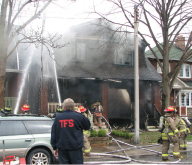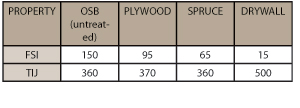
Features
Structural
Training
No more bread and butter: Kitchener-Waterloo study proves new materials burn differently
House fires, or, as they have been traditionally referred to, bread-and-butter operations, are part of the ever-changing world of fire fighting.
June 5, 2008
By Carlin Riley and Al Strong
 |
| So-called bread-and-butter operations are becoming a thing of the past with new, faster-burning construction materials forcing firefighters to re-examine the way they approach structure fires. PHOTOS BY DESMOND BRETT |
 |
House fires, or, as they have been traditionally referred to, bread-and-butter operations, are part of the ever-changing world of fire fighting. Just when we thought we had a handle on things, the construction industry introduced newer, lightweight building materials. These man-made building materials such as parallam and Microllam LVL have affected the construction industry and the consumer in positive ways. These materials have changed the way houses are built, offering owners a greatly expanded open basement with no beams, silent floors and quicker construction times.
However, within the context of the fire service, the implications are not so positive. When these building materials are exposed to heat, new issues arise. Everyone knows, based on experience, that it takes about three minutes for a gang plate to lose its integrity under fire conditions and that truss or support is no longer effective. So, what changes with these new construction materials? Take the same heat and apply it to an area filled with the new materials, which, by the way, contain large amounts of glues and supports made of materials other than metal – as opposed to the metal supports of the past – and we have a recipe for disaster.
The fire and thermal properties of these materials include faster fire spread rates and higher heat release rates, which translates to more rapid deterioration of the structural integrity of a building.
Although current trends don’t yet indicate a major problem, once the data is compiled in a few years a different picture will emerge.
According to a U.S. report in 2003 called Trends in Firefighter Fatalities Due to Structural Collapse, 1979-2002, structural collapse often occurs without warning and can easily cause multiple fatalities.
“Between the years 1979 and 2002 there were over 180 firefighter fatalities due to structural collapse, not including those firefighters lost in 2001 in the collapse of the World Trade Center Towers,” the report says. “Structural collapse is an insidious problem within the fire fighting community. It often occurs without warning and can easily cause multiple fatalities.”
These numbers are sure to rise given the new era of construction materials and methods. So, let’s consider the bread-and-butter incident. The call is made, the trucks are dispatched and typically firefighters would arrive and immediately consider an interior attack. Of course, the scene size-up might dictate differently depending on what you see on arrival. The structures that we have considered for these offensive attacks are type-five construction or a regular house (bread-and-butter).
There is a saying in the firefighter survival program :“There is no such thing as a routine fire”. That said, should we be considering new tactics to deal with the new building construction?
There are stories already circulating in many fire-service groups that these new homes burn so quickly that firefighters didn’t get a chance to get in or, when they did, they had to immediately back out. Should we reconsider our approach given this new construction? The answer is yes. There is no such thing as an acceptable loss of a firefighter. Each incident commander will operate in a different manner given the same incident but what if we instituted new protocols that took the old risk-management model and gave it a turbo charge, saying that if we encounter a newly constructed house under heavy fire conditions on any floor, we do not enter? Again, each incident will have specific needs and present very differently than another, but consider the risk versus gain when dealing with a newly constructed house.
Paul Grimwood, formerly of the London Fire Brigade and now with www.firetactics.com has been working on new suppression techniques for years. He has proposed the “snatch rescue”. This is the rescue of known or visible occupants; no more blind room-to-room searches that we have practised for years. If we are sure that there are no survivors in the structure, why enter?
Let’s take a step back for a moment and discuss the by-products of combustion when dealing with the new building materials. There has been talk lately of suspending flashover training for firefighters due to the carcinogens emitted by particle board. Now, take OSB (oriented strand board), parallam and the numerous other building materials all bonded together with glue and calculate the survivability of an occupant without any safety equipment.
If we see heavy fire we also know that anyone in that structure has very likely succumbed to the event. This is not a pleasant thought for anyone on the scene but how long do we keep sending our firefighters in blindly with the ever-increasing possibility of collapse and the many rapid-fire progress events that are more likely to occur as a result of these new building materials?
Below are some figures that show the differences between conventional lumber and the newer phenol-formaldehyde bonded wood products.
Over the past few years the Kitchener Fire Department and The University of Waterloo have conducted test burns using conventional lumber and the newer, glue-bonded materials to gain a better understanding of how building materials behave during a flashover within a compartment. These results, which have not otherwise been made public, yield some surprises when compared to results using conventional solid lumber. These results prompted a review of the use of these materials with respect to fire activities related to fire search, rescue and suppression.
The thermal properties of these new materials are not completely known but enough information is available in the literature to make a brief comparison.

FSI= Fire spread rate, an index that compares the relative rate that a flame spreads over the material;
Tij = The ignition temperature of the material in Celsius;
Char rate= the rate at which a material chars when off gassing or flaming (min/mm).
(NOTE: The results are subject to a wide range of test conditions and should be considered as nominal only.)
Ignition temperatures (Tij): At a glance, there would appear to be only minor differences between OSB , plywood and dimensional lumber (spruce) in terms of their ignition temperatures.
Fire spread index (FSI): Here, there is significant difference as OSB, once flaming, will spread the fire at more than twice the rate of dimensional spruce. This is a significant factor when considering the rate of fire progress in structures with glulam trusses and OSB sheating.
Char rate: The rate at which char is formed on OSB is about twice that of dimensional lumber. More importantly, at 1.5 min/mm, an 11-millimetre sheet of OSB in a truss, charring on both sides would be totally consumed in about eight minutes and would have less than half its design load capacity in five minutes. This fact has been verified in fire calls across North America.
On the other hand, a 2 x 8-inch dressed spruce joist (3.8 x 19 centimetres) would take about 30 minutes to burn through.
Tthe total amount of heat produced by OSB is not significantly different from that of spruce for the same mass but its maximum rate of heat release is about 30 per cent higher, which accounts for the hotter temperatures in these fires, which was observed in the Kitchener FD/University of Waterloo flashover tests.
So with OSB, flame spread is faster, more heat is released and OSB glulam trusses burn through much faster than their spruce counterparts.
“Over the past two years we have been conducting experiments on flashover in compartments with different construction materials,” says Al Strong of theUniversity of Waterloo fire research group.
“OSB in particular produced the highest heat release and charring rates of those materials tested. This has serious implications for fire fighters in terms of structural collapse when considering entering homes using glulam trusses and OSB sheating.”
A good example can be found on Chief Billy Goldfeder’s www.firefighterclosecalls.com by typing in this link: firefighterclosecalls.com/downloads/FIREBOX14-7.ppt This was taken from a small fire in Baltimore County, Md. When you look through the PowerPoint presentation, look at the amount of smoke and heat damage on the adjacent walls. There is not much evidence of long burn time or the presence of significant heat.
The bottom line is that in the Kitchener FD/University of Waterloo tests, these materials very serious collapse hazards and do not hold up under heated conditions. Smoke emitted from thse materials also presents a serious hazard.
Dave Dobson coined the phrase “smoke is fuel”. This has never been so true. The next time you roll up to a house fire, don’t consider it a bread-and-butter operation, consider it for what it is – a very dangerous situation that is becoming more dangerous with increased risk to our firefighters. Become educated and know what we are getting ourselves into so that we can all make better decisions on the fire groundand start chipping away at the 100-plus firefighters who are killed each year in North America.
Carlin Riley is a captain with the Kitchener Fire Department andco-owner of Ontario Fire Training.
Al Strong, (Ph.D., PENG(ret.), a professor emeritus at the University of Waterloo, has an adjunct appointment in the Department of Mechanical and Mechatronics Engineering, Fire research group. Over the past 15 years he has conducted experimental fire research, worked with the regional fire services and consulted on a number of projects such as the design of fire training facilities and post-incident fire investigations.
Print this page